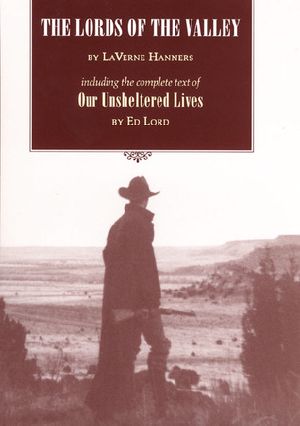The Lords of the Valley · Including the Complete Text of ’Our Unsheltered Lives’

- Authors
- Hanes, Bailey C.
- Publisher
- University of Oklahoma Press
- Tags
- test
- ISBN
- 9780806128047
- Date
- 1996-03-15T00:00:00+00:00
- Size
- 1.40 MB
- Lang
- en
The Lords of the Valley is the intertwining of two voices, one male and one female, to tell the story of life in and around a tiny, remote ranching community on the Oklahoma/New Mexico border from the 1890s through the 1930s. La Verne Hanners’s gentle, helpful commentary is woven through the unaltered text of Ed Lord’s "Out Sheltered Lives," a curt, no-nonsense account of his life as a cowpuncher, freighter, and storekeeper in Kenton, Oklahoma. Hanners also was a longtime resident of Kenton.
Lord and hanners both describe a way of life that demanded toughness-stoicism, commitment, and humor when possible-but their recollections make an interesting counterpoint. Following the branding and castration of a thousand young bulls, Lord insists that the entire town came with buckets to carry the testicles home-"They were really meat hungry." Hanners insists, however, that cooking and eating mountain oysters was "strickly a masculine endeavor," pursued by the men after the women had vacated the kitchen. When Lord matter-of-factly describes being left alone at a young age to trail cattle in Indian Territory, Hanners observes that "sixteen seems pitifully young to be so far away from home, broke and hungry," while agreeing that necessity often required such things. When Lord says there were saloons because the men "had to have a place to drink and fight in," Hanners remembers the many saloons that mysteriously burned to the ground. And when Lord flatly says, "Our first baby was killed. I will tell about it now," Hanners thinks of a number of other children buried in the Kenton cemetery.
Over Kenton looms the colossal Black Mesa. Hanners describes it vividly, yet Lord writes his entire book without mentioning, let alone describing it. Nevertheless, we learn a great deal from him, and his feelings surface, especially when he affectionately mentions his wife, Zadia.
Both Lord and Hanners survive not only Kenton, but modern life. In a postscript written in 1964, Lord, who has retired with Zadia to Leisure World in California, grumbles that he has to stop writing and go wash off the patio. In 1994 Hanners, having lived away from Kenton since early adulthood, returns there to live and write.
Forty-nine photographs and five maps accompany the text.